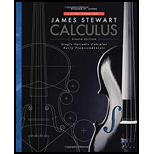
Study Guide for Stewart's Single Variable Calculus: Early Transcendentals, 8th
8th Edition
ISBN: 9781305279148
Author: Stewart, James, St. Andre, Richard
Publisher: Cengage Learning
expand_more
expand_more
format_list_bulleted
Concept explainers
Question
Chapter 7.6, Problem 2PT
To determine
To choose: The appropriate option for the number of the
Expert Solution & Answer
Want to see the full answer?
Check out a sample textbook solution
Students have asked these similar questions
Sox & Sin (px) dx
0
8
L
8
e
ipx dx
Find the Taylor polynomial T³(×) for the function f centered at the number a.
f(x) = xe-2x
a = 0
T3(x) =
Chapter 7 Solutions
Study Guide for Stewart's Single Variable Calculus: Early Transcendentals, 8th
Ch. 7.1 - Prob. 1PTCh. 7.1 - Prob. 2PTCh. 7.1 - Prob. 3PTCh. 7.1 - The integration by parts rule corresponds to which...Ch. 7.2 - By the methods of trigonometric integrals, sin3 x...Ch. 7.2 - Prob. 2PTCh. 7.2 - The first step to evaluate cos4 x dx is to...Ch. 7.2 - ∫ sin 3x cos 6x dx =
Ch. 7.3 - Prob. 1PTCh. 7.3 - Prob. 2PT
Ch. 7.3 - Prob. 3PTCh. 7.3 - Prob. 4PTCh. 7.4 - Prob. 1PTCh. 7.4 - Prob. 2PTCh. 7.4 - Prob. 3PTCh. 7.4 - Prob. 4PTCh. 7.4 - Prob. 5PTCh. 7.5 - Prob. 1PTCh. 7.5 - Prob. 2PTCh. 7.5 - Prob. 3PTCh. 7.5 - Prob. 4PTCh. 7.5 - Prob. 5PTCh. 7.5 - Prob. 6PTCh. 7.6 - Prob. 1PTCh. 7.6 - Prob. 2PTCh. 7.6 - Prob. 3PTCh. 7.6 - Prob. 4PTCh. 7.7 - Prob. 1PTCh. 7.7 - Prob. 2PTCh. 7.7 - Prob. 3PTCh. 7.7 - Prob. 4PTCh. 7.8 - True or False: 23xdx is an improper integral.Ch. 7.8 - Prob. 2PTCh. 7.8 - Prob. 3PTCh. 7.8 - Prob. 4PT
Knowledge Booster
Learn more about
Need a deep-dive on the concept behind this application? Look no further. Learn more about this topic, calculus and related others by exploring similar questions and additional content below.Similar questions
- For each graph in Figure 16, determine whether f (1) is larger or smaller than the slope of the secant line between x = 1 and x = 1 + h for h > 0. Explain your reasoningarrow_forwardPoints z1 and z2 are shown on the graph.z1 is at (4 real,6 imaginary), z2 is at (-5 real, 2 imaginary)Part A: Identify the points in standard form and find the distance between them.Part B: Give the complex conjugate of z2 and explain how to find it geometrically.Part C: Find z2 − z1 geometrically and explain your steps.arrow_forwardA polar curve is represented by the equation r1 = 7 + 4cos θ.Part A: What type of limaçon is this curve? Justify your answer using the constants in the equation.Part B: Is the curve symmetrical to the polar axis or the line θ = pi/2 Justify your answer algebraically.Part C: What are the two main differences between the graphs of r1 = 7 + 4cos θ and r2 = 4 + 4cos θ?arrow_forward
- A curve, described by x2 + y2 + 8x = 0, has a point A at (−4, 4) on the curve.Part A: What are the polar coordinates of A? Give an exact answer.Part B: What is the polar form of the equation? What type of polar curve is this?Part C: What is the directed distance when Ø = 5pi/6 Give an exact answer.arrow_forwardNew folder 10. Find the area enclosed by the loop of the curve (1- t², t-t³)arrow_forward1. Graph and find the corresponding Cartesian equation for: t X== y = t +1 2 te(-∞, ∞) 42,369 I APR 27 F5 3 MacBook Air stv A Aa T 4 DIIarrow_forward
- Middle School GP... Echo home (1) Addition and su... Google Docs Netflix Netflix New folder 9. Find the area enclosed by x = sin²t, y = cost and the y-axis.arrow_forward2. Graph and find the corresponding Cartesian equation for: (4 cos 0,9 sin 0) θ ε [0, 2π) 42,369 I APR 27 3 MacBook Air 2 tv A Aaarrow_forward30 Page< 3. Find the equation of the tangent line for x = 1+12, y = 1-3 at t = 2 42,369 APR A 27 M . tv NA 1 TAGN 2 Aa 7 MacBook Air #8arrow_forward
- Evaluate the following integrals as they are writtenarrow_forwardCalculus lll May I please have the blank lines completed, and final statement defined as a result? Thank you for the support!arrow_forward3. Consider the polynomial equation 6-iz+7z² - iz³ +z = 0 for which the roots are 3i, -2i, -i, and i. (a) Verify the relations between this roots and the coefficients of the polynomial. (b) Find the annulus region in which the roots lie.arrow_forward
arrow_back_ios
SEE MORE QUESTIONS
arrow_forward_ios
Recommended textbooks for you
- Algebra & Trigonometry with Analytic GeometryAlgebraISBN:9781133382119Author:SwokowskiPublisher:Cengage

Algebra & Trigonometry with Analytic Geometry
Algebra
ISBN:9781133382119
Author:Swokowski
Publisher:Cengage
Definite Integral Calculus Examples, Integration - Basic Introduction, Practice Problems; Author: The Organic Chemistry Tutor;https://www.youtube.com/watch?v=rCWOdfQ3cwQ;License: Standard YouTube License, CC-BY